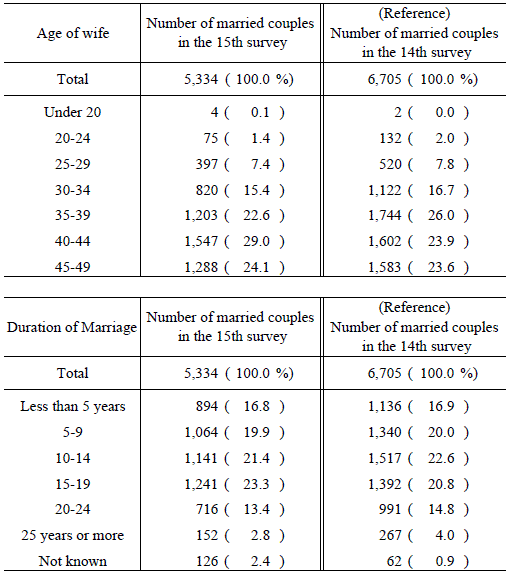![]()
![]()
- Top Page
- Survey:Annual Population and Social Security Surveys
- The 15th Japanese National Fertility Survey
![]()
The 15th Japanese National Fertility Survey
Latest Issue : Released at 31/3/2017
(A survey result report was published in March 2017)
(Publication of preliminary results in September 2016)
These releases provide a summary of the 15th Japanese national fertility survey conducted by National Institute of Population and Social Security Research in June 2015.
Survey results
![]() Highlights of the survey results on married couples/ singles
Highlights of the survey results on married couples/ singles
![]() Summary of the survey results on married couples/ singles
Summary of the survey results on married couples/ singles
(These documents show the points on the report published in March, 2017.)
Overview of the Survey
The purpose and history of the survey
The National Institute of Population and Social Security Research conducted the 15th Japanese National Fertility Survey (Shussho doko kihon chosa) in June 2015. The survey is conducted to determine the current situations of and background to marriage and/or fertility of married couples, which are not available in other public statistics, and also to obtain the basic data necessary for developing relevant polices and projecting the future population. The first National Fertility Survey was carried out in 1940 (prewar) and the second one in 1952 (postwar). Since then, it has been conducted every five years, investigating process of marriage and fertility of married couples. Since the 8th Survey (1982), a survey of unmarried persons has been conducted simultaneously with that of married couples.
Survey procedures and data collection
This study was conducted by self-enumeration method. The questionnaires were
distributed by survey staff, and the respondents placed the completed questionnaire in the
envelopes provided before they were collected by the staff.
The survey was conducted in 900 districts selected by systematic sampling from the 1,106
districts where the Comprehensive Survey of Living Condition of the People on Health and Welfare,
2015, was conducted by the Statistics and Information Department of the Minister’s Secretariat in
the Ministry of Health, Labour and Welfare. The 1,106 districts were originally selected by a
stratified random sampling procedure from the 2010 Population Census tracts. The targeted subjects
of this survey are all married women under 50 years old and all singles (men and women) aged 18 to
49 residing in these 900 districts.
[Singles Survey] Of the 11,442 distributed questionnaires (the number of subjects surveyed), 9,674
questionnaires were collected, yielding a response rate of 84.5% (the figure was 80.6% for the
previous survey). Nine hundred and twenty-two (922) of the collected questionnaires that were not
properly filled out were considered invalid and were excluded from the analysis. Thus, the
number of valid questionnaires was 8,752 and the valid collection rate was 76.5% (74.3% for
the previous survey). This report presents the results of analysis based on the responses of
never-married men and women aged 18 to 34 (unless otherwise stated) .
[Married Couples Survey] Of the 7,511 distributed questionnaires (the number of subjects surveyed), 6,867 questionnaires
were collected, yielding a response rate of 91.4% (the figure was 91.2% for the previous survey).
Two hundred and sixty nine (269) of the collected questionnaires that were not properly filled-out
were considered invalid and were excluded from the analysis. Thus, the number of valid
questionnaires was 6,598 and the valid collection rate was 87.8% (86.7% for the previous survey).
This report presents the results based on 5,334 first-marriage couples(*).
[*: In this report, the term “first-marriage couples” will be used to refer to couples for whom the
current marriage is the first one for both husband and wife.]
Table 1 Sample size and response rates

Table 2 Number of never-married persons, by age and sex

Table 3 Basic characteristics of respondents: Ages of wife and duration of marriage
(first-marriage couples)



